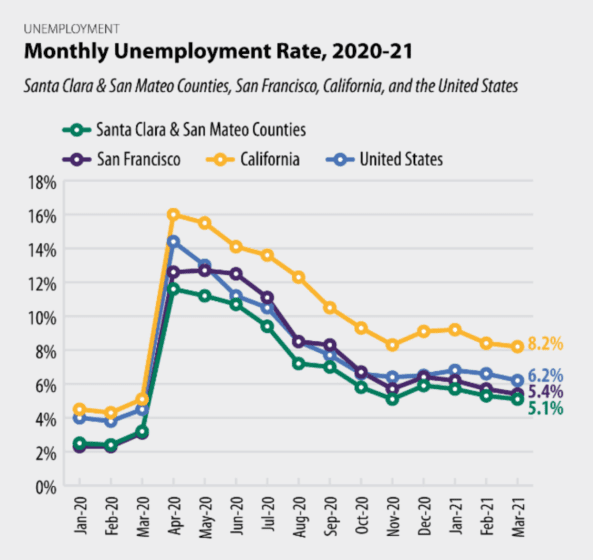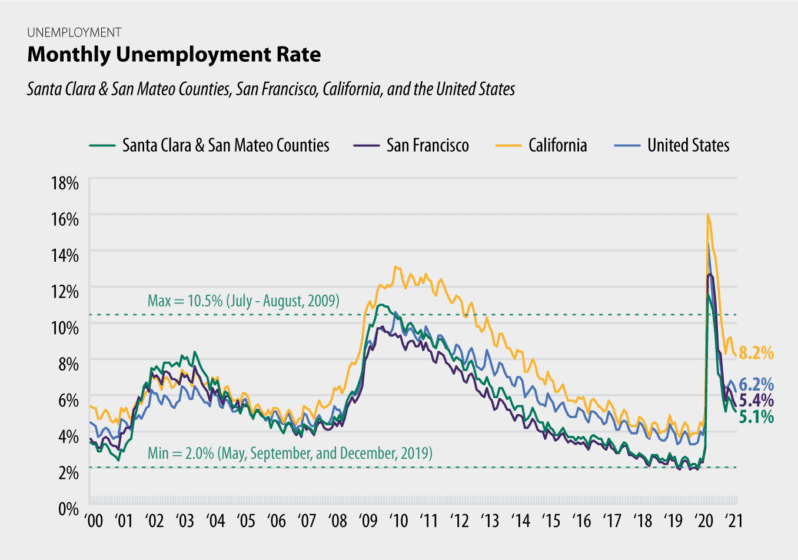A new jobs analysis from a regional nonprofit think tank suggests Silicon Valley is slowly recovering from the economy’s tumble last year. But the region has a long way to go before getting to pre-pandemic levels.
The data analysis comes from Joint Venture Silicon Valley’s Institute for Regional Studies, the nonprofit’s research arm that publishes the Silicon Valley Index annually. The analysis follows an April 16 release of jobs data from the California Employment Development Department (EDD).
The analysis shows Silicon Valley, defined by Joint Venture as the combination of Santa Clara and San Mateo counties, has recovered better from the pandemic’s record job losses than the state and the rest of the country. In March, the region notched 5.1% unemployment, compared to a statewide unemployment level of 8.2% and nationwide level of 6.2%.
It’s a significant decrease from last April when 11.6% of Silicon Valley workers were out of a job, but only a slight decrease since December’s 6% unemployment rate as the winter surge of COVID-19 cases took hold and the region locked down again.
These promising numbers, however, don’t necessarily guarantee a robust recovery, says the institute’s Director of Research Rachel Massaro.
“In a lot of respects it’s too early to know,” Massaro said. “We have had a significant change in the case counts of COVID based on the vaccination roll out. That’s fantastic, but the pace of that isn’t more rapid, at the moment, than the reopening of (the economy).”
Meanwhile, the EDD’s numbers are always a month delayed and fail to take into account the rapidly changing nature of the pandemic, vaccine distribution and people’s desires and fears.
“I think between mid-March and mid-April, all of us here in the community can tell that there’s been more activity,” Massaro said. “But the employment numbers (for the last month) just aren’t out yet.”

Massaro warned that the goal for the region and the state should not just be to “get back to normal.” She said there’s a chance to learn from the losses of the pandemic and bring disenfranchised groups along for future growth.
“One should hope we are building our region back better,” Massaro said. “Not only recovering, but that we are recovering equitably and we’re bringing people back to work at good jobs.”

The regional numbers look better than the state’s, for example, because a huge chunk of the labor force is made up of tech workers.
“More than a quarter of our jobs are in the tech industry, and that industry has weathered the pandemic pretty well,” Massaro said. “They switched to primarily a remote work force at the beginning of the pandemic, and that’s really helped to keep unemployment numbers low.”
As of mid-March, approximately 73,000 people in Silicon Valley’s labor force remained unemployed, with 21,300 in San Mateo County and 51,700 in Santa Clara County. This compares to 48,000 at the same time last year.
But just because residents have jobs does not mean they’re secure. A San Jose McDonald’s employee, Ignacio Valencia, says he had trouble making ends meet even though he worked during the pandemic.
“I used to have two jobs, now I have one,” Valencia said. “I used to work for this Italian restaurant, but since people don’t come in, I no longer work as a dishwasher.”
Other workers reported to Santa Clara County’s wage theft coalition their employer’s unwillingness to disburse quarantine pay if they tested positive for COVID-19.
Fast food worker Clyde Delgado said he experienced wage theft during the pandemic. Delgado had recently immigrated to the South Bay from the Philippines in fall 2019 and was desperate to provide his family with extra income.
Delgado said management was indifferent to his safety.
“We had trouble implementing social distancing and customers would complain workers were crowded in the front (of the restaurant),” Delgado said. “We also could not take our 10-minute rest breaks or else people would be left doing too much in the front… and when we said there was too much and we have to pause taking orders, the management (forbade) us.”
Statewide trends
California overall saw decent, if not slow, job gains in March as unemployment rates decreased 0.2% from 8.5% to 8.3%. Overall, the state’s employers gained about 120,000 jobs, according to the EDD.
Those numbers are still nearly twice the rate compared to March last year, when only 4.5% of the state’s workers were unemployed, about 1.5 million residents. Meanwhile, only about 680,000 residents filed for unemployment, according to the state.
Those filers include San Jose residents grappling with a delayed and overburdened unemployment insurance system.
Contact Madelyn Reese at [email protected] or follow @MadelynGReese on Twitter.


Leave a Reply
You must be logged in to post a comment.